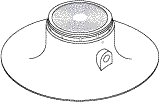 General Information
General InformationGreen Roofs
Rainwater Harvesting
Ponds and Wetlands
Systems
Liners
Filters
Pumps
Plumbing
Fountains
Water Quality
Aeration Systems
UV Sterilizers
Vacuums
Biological Controls
Chemical Controls
Other Products
Documents
Energy-Efficient Building
Waterproofing

POND WATER QUALITY
Although algae are an essential part of the natural ecosystem in any healthy pond, uncontrolled algae growth can produce green water, low oxygen levels, and unpleasant odors. We suggest the following measures to keep algae from proliferating:
![]()
LIMIT THE FISH POPULATION: Fish waste is a rich source of rapid-release plant nutrients which makes it an ideal food supply for algae. The single best way to avoid algae problems is to keep the fish population as low as possible– we recommend no more than one inch of fish for every square foot of pond surface. As fish grow and reproduce, give some away to new pond owners, but never release them into the wild since they can disrupt natural ecosystems. Consider adding a predator fish as a means of population control.
ADD PLANTS: Plants shade the water and extract nutrients from the water, depriving algae of the sunlight and food they need to flourish. Consequently, the best plants for algae control are those with extensive leaf structures such as water lilies, or those that have a voracious appetite for nutrients such as water hyacinths or anacharis. Rapid-growing plants should be pruned or harvested frequently and added to the compost pile.
ADD BACTERIA: By supplementing the natural bacterial population with large infusions of liquid or dry bacteria, it's often possible to solve algae problems and simultaneously eliminate excess organic matter that collects at the pond bottom and can serve as a continuing nutrient source. The introduced bacteria grow rapidly, consuming all the available nutrients in the pond water, starving the algae. At the same time, the bacteria transform some of the dissolved nitrogen compounds that would otherwise become algae food into nitrogen gas that diffuses into the air. Some bacterial preparations also include enzymes that break down accumulated leaves and other organic matter, releasing nutrients into the water that are then consumed by the bacteria.
ADJUST THE POND CHEMISTRY: Algae problems are often associated with high pH levels. Measure the pH and level with test strips and adjust as needed with pH controls. When adjusting the pH, be certain to check the buffer level and adjust it also if necessary.
IMPROVE FILTRATION: Ponds with fish need effective filtration. An effective filter systems must provide mechanical filtration, aerobic biological filtration, and anaerobic biological filtration. Mechanical filtration separates floating solids from the water and is accomplished by leaf nets, strainer screens, foam sponges, polyester matting, or vortex tanks. Aerobic biological filtration transforms the toxic ammonia from fish waste into nitrates and is accomplished by aerobic microorganisms that thrive on the oxygen-rich external surfaces of most filter media. Anaerobic biological filtration completes the process by transforming these nitrates into nitrogen gas and is accomplished by anaerobic microorganisms that grow in places without oxygen, such as in the interior cavities of ceramic rock, reticulated foam, and some types of plastic media. Many inexpensive "biofilters" don't work very well because they have inadequate surface area to support a large population of aerobic microorganisms and very often have no media to support anaerobic microorganisms.
ADD A UV STERILIZER: Intense ultraviolet (UV) radiation can kill algae by breaking down their DNA molecules, an environmentally safe process that does not leave any residue in the water. A UV sterilizer is basically a plastic pipe with an ultraviolet lamp inside that is installed in the return line between a filter and a pond or between a pump and a filter. We strongly recommend UV sterilizers for ponds with substantial fish populations, especially koi ponds, to help control algae and disease-causing microorganisms. They are also a valuable tool for eliminating green water in any pond, but should not be seen as a substitute for effective filtration. Since UV sterilizers add nothing to the water, they have no effect on string algae and other aquatic life that remain in the pond and do not pass through the pumping system.
INSTALL AN AERATION SYSTEM: Compressed-air aeration offers a simple and inexpensive way to dramatically improve water quality in larger ponds by lifting water from the bottom of the pond to the surface where dissolved gases in the water to escape into the atmosphere and oxygen in the atmosphere to diffuse into the water. Over time, this process can break down thick accumulations of organic material at pond bottoms, particularly when supplemented with the addition of bacteria.
KEEP THE POND CLEAN: While plants are beneficial, their dead leaves can become a major nutrient source for algae. Trim brown leaves from aquatic plants, use a fish net to collect leaves that fall to the bottom, and cover the pond with a leaf net in the Autumn before surrounding trees lose their leaves. If organic matter accumulates, it will be necessary to empty and clean the pond in the early Spring, but never empty the pond during other seasons since cleaning removes the beneficial microorganisms essential to maintaining clean water and disrupts the operation of biological filters. If used regularly, pond vacuums can remove excess organic matter.
TRY BARLEY STRAW: For centuries farmers have thrown bales of barley straw into ponds as a means of controlling algae. Recent research has shown that as the straw decomposes, it emits a natural algal growth inhibitor. Although pondkeepers have had mixed results, barley straw is so inexpensive that it's worth trying.WAIT A WHILE: Spring algae problems may disappear on their own once plants begin to grow; summer algae problems may disappear after a really hot spell ends.





